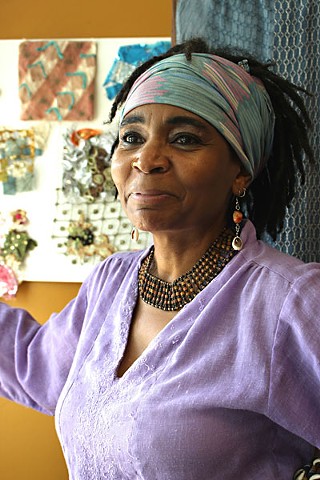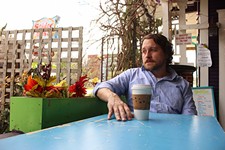The Good Eye: You Say You Want a Resolution
Austin's budding fashion industry gets a vote of confidence – and a shot at diversity
By Amy Gentry, Fri., Aug. 29, 2014
When I hear the words "fashion district," my mind jumps immediately to that mythical institution that keeps broke New York girls looking chic: the sample sale.
But designer bargains are just the beginning of what a fashion district could mean for Austin, says local designer Nailah I. Akinyemi-Sankofa, director of RunWay Underground and proponent of a resolution recently passed by City Council that she hopes will eventually lead to such a district on the Eastside. Resolution 111 recognizes the establishment of a Fashion Industry Council of Austin, a group of industry professionals interested in beefing up the back end of Austin's garment industry to make local sourcing synonymous with the fashion industry here, the way that locavore and craft ingredients have become synonymous with our foodie culture.
In a maker city like Austin, this sounds like a no-brainer. As Leslie Bonnell of Stitch Lab can attest, the DIY and home-sewn movements have exploded here – along with a concentration of creative talent far out of proportion with local job opportunities. Just last week, the saleswoman ringing me up at a local boutique told me she wants to launch her own jewelry line. She's not alone.
But as I've learned writing this column, it's extremely hard to move small lines into production locally. From start-up textile line Rekh & Datta to jewelry designer Suzanna Dai, most local brands get their designs manufactured abroad. Many, like Raven + Lily, partner with small communities in developing countries to foster sustainable economic growth. But meanwhile, the huge backlog of large orders over at Mr. and Mrs. Sew It All testifies to a real need for local garment-workers. In a town with as many socially conscious sewing hobbyists as Austin, is it a huge stretch to imagine we could manufacture our own garments here – and while we're at it, develop the broad array of industry skills, from fine hand-finishing techniques to event production, that would take our fashion scene to the next level?
Beyond that, Sankofa sees an Austin-based garment industry as a way to create middle-income jobs of the sort that brought her parents success back in the Sixties in her hometown of Chicago – even without college degrees. "I remember when The Cosby Show was on, everybody was like, 'Black people don't live like that.' But all the black people I knew lived like that! They just weren't doctors and lawyers."
The middle class is shrinking everywhere, but in Austin, the black middle class specifically is pulling a vanishing act, according to a report released in May by the University of Texas Institute for Urban Policy Research and Analysis, which called attention to Austin's dwindling black population. Sankofa thinks fashion-related jobs might just bring them back.
Sankofa started designing as a child, making clothes for an oversized Barbie doll and educating herself on design by any means necessary. "My father, he had two jobs. He worked at the high school as a custodial worker, and he also worked for American Airlines – he was one of the guys that prepped the plane between flights. They would throw the magazines out, and he would bring them home. That's how I got fashion magazines. When we'd get a Vogue, I was ecstatic ... I lived in those magazines."
Eventually, she took drafting classes and went into interior design. One of nine sisters, all but one of whom sew, she first became interested in sewing from the perspective of pattern-drafting. In the late Eighties, she made jewelry that was sold at By George. "That's one of the reasons I decided I needed to move to Austin," she says.
By the mid-Nineties, however, black artists and designers were already leaving. "What I call the old heads, they were getting tired. You reach an apex where you're struggling so much, you either give it up, or you leave so you can have more success. Or you stay here and stick it out, but you're maybe not doing it as much .... If people are worried about paying bills and putting food on the table, the last thing they can think about is the luxury of designing, the luxury of art. Unless you're crazy, like some of us," she adds with a grim smile.
Katrina refugees offset another exodus of black artists in the mid-Aughts, but only temporarily. In 2008, Sankofa got together with like-minded locals to found RunWay Underground, an organization for mentoring and promoting African-Americans in fashion. "I was on the phone with one of my closest friends, telling her about South Africa. They have Mercedes-Benz Fashion Week, but a lot of the black designers there couldn't afford it, or else they couldn't get in. So they were having shows, really polished shows with beautiful fashions, but in alleys, under bridges. Renegade, guerrilla shows. She was like, 'Nailah, you have to do some things that are underground – just like we always talk about our ancestors who were on the Underground Railroad.' That's where the name came from."
It started with phone calls. "I would say, 'You just did this major show or event, did you have any black designers? You have this boutique in the Second Street district, do you have any black designers in your store?' ... 'We're not sure, we don't know the ethnicity of our designers.' Well I kind of buy that, except I also don't," she says. "There are photos in the press packets!"
But ultimately, Sankofa's focus is on building partnerships for a big-tent fashion initiative that, if it comes to fruition, could raise standards for everyone.
Sankofa describes her dream: "I see textile mills that have moved in, maybe somebody who makes buttons or sewing supplies. Buildings with retail on the bottom floor, and upstairs there's designers' studios, showrooms, workrooms, and spaces where people are learning to sew. I see all these trucks going back and forth delivering stuff, racks going back and forth in between buildings." And, of course, "There's fashion shows going on."
Best of all, "I see all these different-colored people moving around. We'll get Chinese food on the Eastside! I can get a box of shrimp fried rice, and then go out for African food!" That sounds even better than a sample sale.











